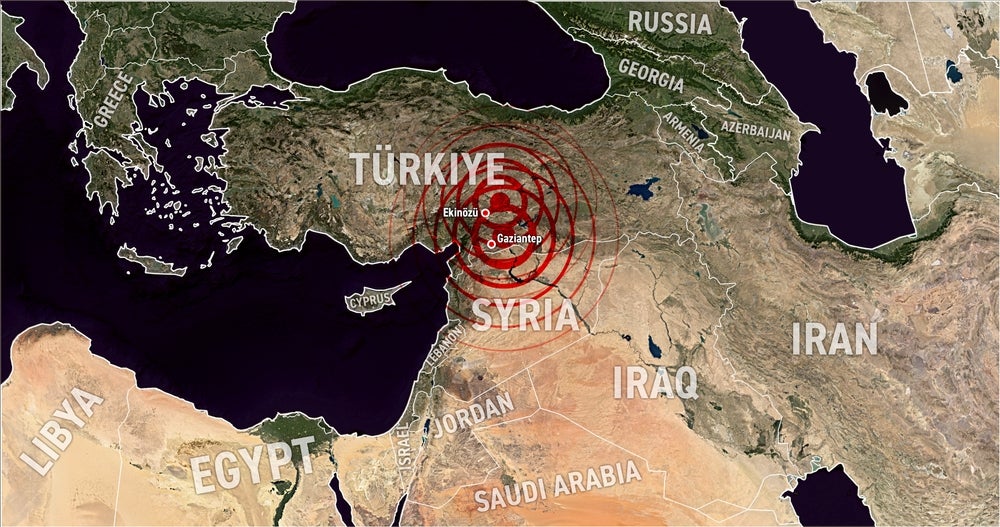
Almost three weeks on from Türkiye’s devastating earthquakes, Altan has revealed almost a third (between 20% and 35%) of workers in the apparel and textile industries are employed in the region and is urging international apparel and textile partners to donate to the TGSD.
In fact, he says 1,616 garment and 1,290 textile companies operate within the 11 provinces that were affected, with the apparel sector employing almost 150,000 workers and nearly 200,000 people working in the textile industry.
He explains: “TGSD will be supporting this region by donating containers, and wants to decrease the social impact by creating a working environment.”
He adds that donations will serve the ultimate goal of providing employment in the region, and will help to start manufacturing again in full capacity.
“We really appreciate your donation contributions to TGSD. Having a house and a place to work will definitely help improve living standards and normalise processes in the region.”
Altan explains TGSD was mobilised from the very first day to support people affected by the earthquakes. It is working with members and stakeholders to identify and fulfil actual needs in the region.

US Tariffs are shifting - will you react or anticipate?
Don’t let policy changes catch you off guard. Stay proactive with real-time data and expert analysis.
By GlobalDataHe says: “We strongly believe that we will overcome these difficult days by working together with our local as well as international partners in unity and solidarity.”
Three weeks on: update on impact of Türkiye earthquakes for apparel industry
He is keen to share an update with the wider apparel industry on the impact of Türkiye’s earthquakes for the garment and textile industry and points out it is very rare to have two such big earthquakes on the same day.
He explains the two major devastating earthquakes with magnitudes of 7.8 and 7.5 hit southeast Türkiye and northern Syria on 6 February.
There were 11 cities (namely Kahramanmaraş, Malatya, Hatay, Gaziantep, Adıyaman, Osmaniye, Kilis, Şanlıurfa, Adana, Diyarbakır and Elazığ) that were affected enormously by the major earthquakes and their aftershocks.
He says almost 13.5 million people living in these cities are affected with more than 41,000 people losing their lives, 125,000 injured and 85,000 buildings demolished or damaged, according to an official announcement made on 19 February.
Main industries affected by Türkiye earthquakes are textile and apparel
Altan highlights there are 36 industrial zones in ten cities that were affected by earthquakes and the main industries in the region include manufacturing, textile, apparel, steel, cement and agriculture.
The apparel exports from the region was US$565m in 2022 making up 2.6% of total apparel exports. Textile exports on the other hand were $3.4bn generating 30% of the total Turkish textile export last year. Almost half (45%) of the production capacity is located in this region.
He says there are garment factories in Malatya, Elazığ, Şanlıurfa and Adıyaman and textile mills in Kahramanmaraş and Gaziantep, however the impact on other factories located in Malatya, Elazığ, Şanlıurfa Kahramanmaraş and Adıyaman are minor.
Thankfully, infrastructure systems in industrial zones are mostly in good condition and the factories are usually in industrial zones with single-storey buildings. For this reason the devastating effect of earthquakes is less on production plants than it is on residential buildings.
Short-term production cuts for Türkiye apparel industry
Short-term production cuts are inevitable for the apparel industry following Türkiye earthquakes, he suggests however all stakeholders are working together to restart plants for social reasons as well as economical reasons.
He points out that infrastructure-wise, the government has started to supply water, electricity and natural gas to some cities, towns, and industrial zones and airports are in operation.
In fact, manufacturing has already started in some factories in Malatya, Elazığ and Şanlıurfa, and Altan explains that in the short-run, Turkish textile and garment industries will use their excess production capacity built in 2021 and 2022.
For instance, he says: “Türkiye had increased yarn and fabric production capacity by 25% last year with new investments. Therefore, the lost capacity can be immediately replaced by the available capacity in other major cities like Bursa, Istanbul, Tekirdağ and Denizli located in the West.”
He adds: “Temporary cities built up from containers around the industrial zones are under construction in order to prevent workforce immigration.”
The importance of donating right now
TGSD has been allocated a pilot area of 22,000m2 in Adıyaman near the industrial zone to establishing an accommodation centre including healthcare centre and child daycare centre for more than 1,500 people.
TGSD is supporting this region by donating containers, and help establish to decrease the social impact by creating working environment, however in addition to shelter requirements, there is still a need for winter tents, sleeping bags, heaters, outwear and underwear.
Altlan explains international partners can either contribute in cash or by bank transfer to TGSD or directly provide these materials and explains TGSD will be sharing the progress of the project with all contributors in a timely manner.



